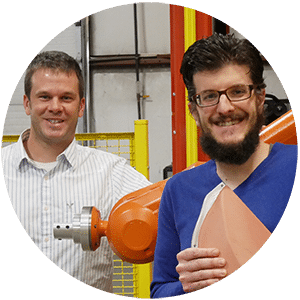Vistex Composites makes advanced thermoset and thermoplastic composite products. The Schenectady, New York company also sells the process that it developed to other composites manufacturers who want to increase efficiency. In addition to product fabrication, Vistex Composites offers tooling for reduced cycle times, production costs, energy usage, and consumable waste. Product development and consulting services round-out the company’s portfolio of capabilities.
Vistex Composites was founded in 2012 by two graduate students from Rensselaer Polytechnic Institute (RPI) in Troy, New York. Today, Jaron Kuppers is the chief technical officer (CTO) and Casey Hoffman is the chief operating officer (COO). “I get stuck with all of the grant writing and R&D work,” Kuppers laughs. “Casey has to put up with all of the day-to-day stuff that makes starting a company challenging.” Together, the RPI grads have built a business that’s poised for growth.
RPI Roots and R&D Funding
When Kuppers and Hoffman were at RPI, they worked on research projects for Daniel F. Walczyk, Ph.D., PE, Associate Director of Manufacturing for the Center of Automation Technologies and Systems (CATS). This NYSTAR-funded Center for Advanced Technology (CAT) provides applied manufacturing research and development (R&D) that helps client companies meet specific business objectives. Eventually, Kuppers and Hoffman would go from helping businesses to starting one of their own.
As part of a project under the direction of Dan Walcyzk, Kuppers and Hoffman needed to cure parts that required the application of temperature and pressure during final part manufacturing. “The way it’s done in industry is slow and cumbersome,” Kuppers says. Thus began the search for a better way – and the genesis of Vistex Composites.
When the startup needed to tackle tasks like sourcing equipment and services, Senior Research Engineer at RPI CATS Glenn Saunders knew where to look and who to ask. “RPI CATS has a lot of connections throughout New York State,” Hoffman explains. “Their network is a huge benefit.” Today, Vistex Composites has contracts with RPI CATS in Troy and valuable relationships with other R&D resources in New York State and beyond.
“We have been very successful in obtaining grants to advance our technology,” Hoffman says, citing the company’s participation in the federal government’s Small Business Innovation Research (SBIR) program, which helps domestic small businesses with a strong potential for technology commercialization to engage in R&D. “We now have the opportunity at a Phase 2B,” Hoffman adds, explaining that “for every dollar we raise in investment or revenue, the National Science Foundation (NSF) will give us 50 cents.” This makes the company extremely attractive to investors, as well as to other types of organizations.
Because the Vistex Composites manufacturing process promotes energy efficiency, the company has received several rounds of funding from NYSERDA, the New York State Energy Research and Development Authority, a public benefit corporation located in Albany. “NYSERDA has been amazing to work with,” Hoffman says. Today, Vistex occupies a 4500-sq. ft. manufacturing facility that’s been fit-up so that the company is ready to ramp-up production.
Automated Production and Customer Acquisition
At its manufacturing facility in Schenectady, Vistex Composites has CNC cutting tables for preparing materials. The company also owns several hydraulic presses, including one very large machine capable of manufacturing products up to 3-ft. by 4-ft. in size. Vistex’s equipment list also features a six-degrees of freedom robotic arm that’s used for trimming and automating processes. The company’s commitment to automation has led to a collaboration with another RPI-based resource, Dr. John T. Wen at the Advanced Robotics Manufacturing (ARM) Innovation Hub.
“Vistex is excited to announce that it has recently partnered with the Advanced Robotics in Manufacturing (ARM) Institute and General Electric R&D on a $1.41M research effort to improve manufacturing productivity,” Hoffman says. “The objective of this work is to demonstrate efficient placement and alignment of large, flexible composite wind blade panels utilizing industrial automation.” The ARM Institute is based in Pittsburgh at Carnegie Mellon University, but the Mid-Atlantic Regional Robotics Innovation Collaborative (RRIC) is co-led by RPI and FuzeHub.
As Vistex Composites looks ahead, the company’s future seems especially bright. “We’re really focused on customer generation,” Hoffman says. “Business development is the focus.” Next month, Kuppers and Hoffman will attend CAMX 2017, The Composites and Advanced Materials Expo, in Orlando, Florida. As part of this industry-leading event, Vistex Composites has been selected as a finalist for the prestigious Awards for Composites Excellence (ACE) competition.
While the co-founders are away, two part-time employees – an interim CEO and a student intern in mechanical engineering – will be hard at work in Schenectady. “We hope to double in size and want three technicians for production work,” Hoffman says of the company’s plans for 2018. “We’re progressing beyond R&D and are ready to acquire customers.”

